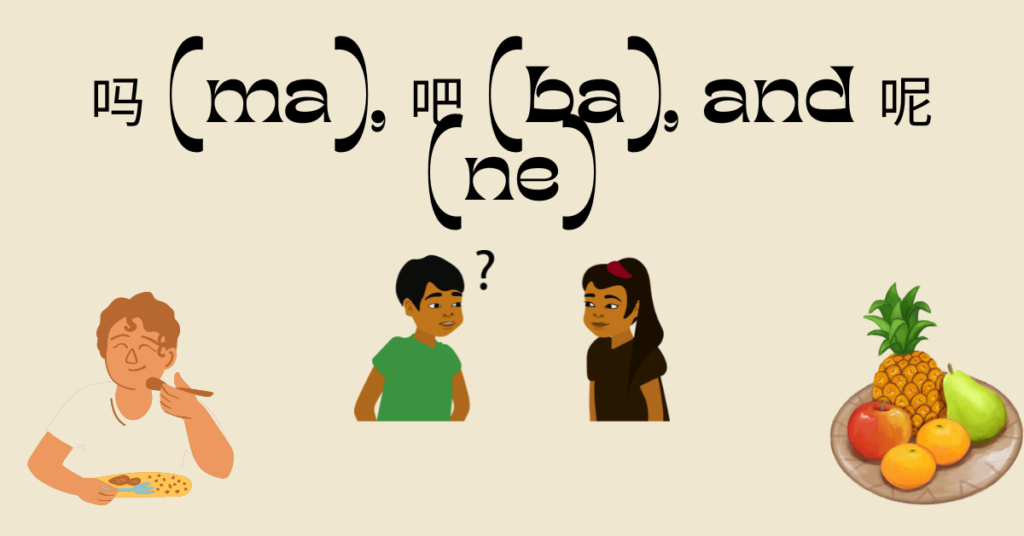
Here’s a detailed explanation of the common Chinese grammar patterns for 吗 (ma), 吧 (ba), and 呢 (ne), along with examples:
1. Clause + 吗:
Structure: This pattern is used to form a yes-no question by adding 吗 (ma) at the end of a declarative sentence.
- Example: 你喜欢吃水果吗?(Nǐ xǐhuān chī shuǐguǒ ma?) – “Do you like to eat fruits?”
- In this pattern, 吗 (ma) turns a statement into a question, inviting a response of “yes” or “no” from the listener.
2. Clause + 吧:
Structure: This pattern is used to express a suggestion or make a soft request by adding 吧 (ba) at the end of a sentence.
- Example: 我们一起去吃饭吧。(Wǒmen yīqǐ qù chīfàn ba.) – “Let’s go eat together.”
- 吧 (ba) at the end of a sentence indicates a suggestion, invitation, or seeking agreement from others.
3. Clause + 呢:
Structure: This pattern is used to ask about someone’s action or state by adding 呢 (ne) at the end of a sentence.
- Example: 你在干什么呢?(Nǐ zài gàn shénme ne?) – “What are you doing?”
- 呢 (ne) is used to inquire about the ongoing action or state of the subject, seeking more information or clarification.
These grammar patterns involving 吗, 吧, and 呢 are commonly used in Chinese to form questions, suggestions, or inquiries. Understanding the usage of these particles will allow you to engage in conversations, seek information, and express various intentions in Mandarin Chinese.
Dialogue
Person A: 你今天要去电影院吗?
(Are you going to the movie theater today?)
(Nǐ jīntiān yào qù diànyǐngyuàn ma?)
Person B: 是的,我打算去。你呢?
(Yes, I plan to go. How about you?)
(Shì de, wǒ dǎsuàn qù. Nǐ ne?)
Person A: 我也想去,我们一起吧!
(I also want to go. Let’s go together!)
(Wǒ yě xiǎng qù, wǒmen yīqǐ ba!)
Person B: 好主意!我们看什么电影呢?
(Great idea! What movie should we watch?)
(Hǎo zhǔyì! Wǒmen kàn shénme diànyǐng ne?)
Person A: 我听说那部新上映的电影很好看,我们去看吧。
(I heard the newly released movie is very good. Let’s go watch it.)
(Wǒ tīng shuō nà bù xīn shàngyìng de diànyǐng hěn hǎokàn, wǒmen qù kàn ba.)
Person B: 好的,我们见面的时间在电影院门口吧。
(Okay, let’s meet at the entrance of the movie theater.)
(Hǎo de, wǒmen jiànmiàn de shíjiān zài diànyǐngyuàn ménkǒu ba.)
Person A: 好的,到时候见!
(Sure, see you then!)
(Hǎo de, dào shíhòu jiàn!)
In this dialogue, the particles “吗” (ma), “吧” (ba), and “呢” (ne) are used to form different sentence patterns to express questions, suggestions, and seeking opinions.
- Person A asks Person B if they are going to the movie theater today using the question particle “吗.” Person B confirms their plan, and Person A asks the same question back using the particle “你呢” (ne) to inquire about Person A’s plan.
- Person A suggests that they go to the movie theater together using the particle “吧” to express a suggestion or proposal. Person B agrees and asks about the movie choice using the particle “呢” to seek an opinion.
- Person A suggests watching the newly released movie using the particle “吧” to indicate agreement or seeking confirmation. Person B agrees, and they decide to meet at the movie theater entrance.
The particles “吗,” “吧,” and “呢” serve different functions in the dialogue. “吗” is used to form a yes/no question, “吧” is used to make suggestions or proposals, and “呢” is used to seek opinions or responses.
Exercise
- Create your own sentence(s) using 吗 (ma), 吧 (ba), and 呢 (ne)